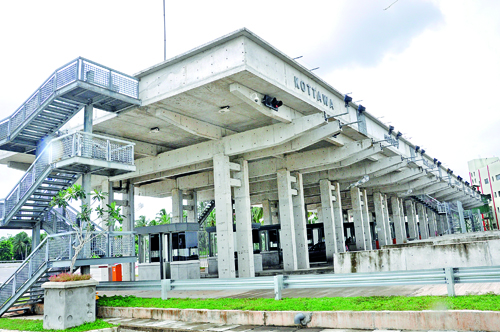Doing it ‘our way’ with toll gates
Dr. Janaka Wijesundara remembers the marshy lands, the paddy fields and the incredibly dusty and uneven planes of the terrain he was presented with. “You couldn’t imagine building anything there,” he says. Tasked with designing the toll gate plazas and office buildings of the Southern Expressway, starting from Kottawa and replicating this 26 more times all the way up to Matara, the architect found himself struggling to visualise a completed structure on the challenging terrain.

“Entryways are important”: The toll gate at the Kottawa interchange. Pix by Susantha Liyanawatte
Things fell into place eventually, thanks to a supportive team and the architect’s own visionary plans. This year the toll gate plazas and offices of the Southern Expressway are one of the nine projects shortlisted for the Bawa Awards for Architecture, now in its third cycle.
It’s a project that has come full circle for the architect who has studied extensively public buildings and spaces both at home and abroad. A graduate of the University of Moratuwa (with both a Bachelors and Masters in Architecture), Dr. Wijesundara obtained his PhD from the University of Aachen in Germany. He spent a few years back in Sri Lanka, working with the Urban Development Authority as Director of Urban Design and then moved to Toronto, Canada, where he spent the next few years practising as a senior urban designer.
It’s an area of design he’s quite passionate about. The role of urban designers in creating liveable, safe and attractive cities is becoming more important by the day, he points out, especially in Sri Lanka’s context. “With the end of the war we’re seeing a huge boom in development work in Colombo and the rest of the country. Urban designers are an important part of this process because our role is to manage these changes sustainably.” Places are almost living, breathing entities of their own, and their character must be taken into account when making drastic changes; it’s with this in mind that Dr. Wijesundara was instrumental in pioneering a Masters programme in urban design at the University of Moratuwa, where he has been a lecturer for the past few years. “It needs to be formalised, and established on a national level,” he reasons.
When he was presented with the opportunity of designing the toll gate structures of the Southern Expressway by the client, the Road Development Authority (under the Southern Transport Development Project), Dr. Wijesundara was determined to create an entity that could stand on its own (literally, of course, but also figuratively!). “With all the time spent abroad I’ve had the chance to study a number of highway buildings,” he shares. “They all had one thing in common-they were generic, too bland.” In designing Sri Lanka’s first ever structure of this nature, Dr. Wijesundara and his team were keen on preserving a sense of identity. “In our country the point of entrance is a sacred thing,” he explains. “You’ll see people, even if they don’t have money, will somehow put up a nice gate when building a house. So in our cultural context entryways are important.” Keeping this in mind, they incorporated a uniquely local

Dr. Janaka Wijesundara
flavour into the structure-for example, you’ll see a subtle flower pattern reminiscent of old buildings on the top beams of most entry points.
There are 27 of these built over the expanse of the Southern Highway; starting from the Kottawa interchange, 21 of these extend up to the Galle exit, while six more were built to reach the Matara exit. The Kottawa interchange houses a large number of toll gates and the small offices that serve the purpose of ticketing was the only part of the structure that was not built on site. Everything else was constructed at the location itself, something architects call ‘in-situ construction’.
The imposing toll gate structures are built with a special type of substance known as fair-faced concrete, a material that is known as the ‘true surface’ of concrete with no falsification, such as cladding or glazing. “There aren’t many buildings that are made with this material, mostly because it’s a fairly difficult substance to work with.” We’re told that famed Japanese architect Tadao Ando, who works with the material, has built a house in the South with it. “It works well for structures like this especially,” shares Dr. Wijesundara. “There’s very little maintenance involved because of the natural colour, and its longevity.”
In building the toll gate plazas, and the accompanying administrative offices, the architect had to consider several traffic engineering and safety standards. One common feature in most highways that they dispensed with was the bumblebee-ish yellow and black stripes prevalent at most toll gates. “It’s unattractive and actually quite unnecessary,” he explains. Instead, each toll gate has two tasteful stripes for indication purposes.
All 27 toll gates come with their own rooftop garden of sorts. An aerial view depicts well maintained little gardens on the ‘roof’ of each structure, an effort by the architect to allow the structures to blend in with the wild scenery they are part of. This is something Dr. Wijesundara is quite keen on; “I was very concerned about the impact of these buildings on the environment around them,” he says. “We needed to build something that was not just exciting and attractive, but also inclusive. It absolutely had to merge with the landscape.”
Which brings us to the inherent simplicity of these structures. The toll gates are essentially a carefully manipulated collection of concrete beams, deceptively effortless and arresting to the eye. “These days it’s very difficult to build something simple,” the architect notes wryly. “So when someone gives you the opportunity, you have to take it.”
The structures have already garnered an award for design from the Sri Lanka Institute of Architects. Dr. Wijesundara is pleased, not because the project has already earned him praise from the architectural community, but because the toll gates are representative of great things to come for the people of the south. “People now have very easy access to the south-not just Galle and the popular tourist destinations, but the towns in between because the interchanges lead to routes that go through them. Over the past few years they have developed significantly.” For the consummate urban designer at heart, this is testament to what clever, thoughtful architecture and planning can achieve. It’s for this very reason that he advocates the inclusion of urban designers into engineering projects; “it takes an architect to visualize the end result,” he says.


